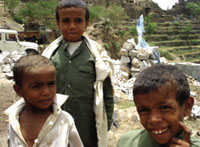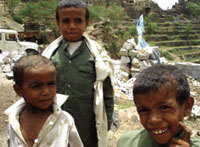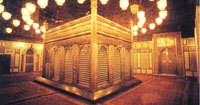
Yemen has more than 40,000 internally displaced people due to Sa’ada war [Archives:2008/1176/Reportage]
July 28 2008
 |
For The Yemen Times
Although President Ali Abdullah Saleh has declared that the war between the Yemeni army and Houthi loyalists in Sa'ada is now over, its impact remains obvious, particularly to the numerous internally displaced peoples – known as IDPs – who have been rendered homeless as a result of the lengthy fighting.
This is especially evident in Harf Sifyan, located between Sa'ada and Amran governorates, and Bani Hushaish just outside of Sana'a, where the conflict has left a wake of both personal and property damage.
Dozens of families in these restive areas now are homeless and hundreds of formerly healthy individuals now are handicapped due to the continuous fighting.
This is the case for some 700 families who evacuated their homes in Harf Sifyan and approximately 100 families forced to evacuate their homes in Sa'ada's Bani Suraim and Houth districts, fleeing to the surrounding villages of Al-Eshah, Jabal Eial Zaid, Maswar and Amran city, in addition to other remote areas.
“We don't have anything to eat and the water is undrinkable,” reported one man from an 11-member family in Harf Sifyan, who wished to remain anonymous for safety reasons. “We drink from ponds and live in deserted old homes, schools or mosques because we don't have tents. All of the places we live in are crowded with other families who have suffered a similar fate,” he noted.
“Many homes were destroyed and looted after residents left their farmlands and businesses. We now live in a miserable and unsettled situation,” the man said, adding that the fighting prevented his four sons, who left school, from returning to take their exams.
Another 40-year-old man requesting anonymity for security reasons recounted that his wife and children were fear-stricken after a fighter jet destroyed their home and surrounding property on the first day of the most recent outbreak of fighting.
“I still remember that day when I was with my family and being subjected to gunfire during the battle between the two sides,” the man recalled, adding, “I couldn't believe we had survived until I was about a kilometer away from the battlefield.”
“The disaster that has befallen those in these warring areas is unforgettable,” remarked another former Harf Sifyan resident in his 20s. “Several soldiers looted homes, taking everything inside – gold, guns, anything valuable.”
Some residents of the war-torn areas allege that their properties were looted and their homes subjected to air strikes without prior notification by government forces, who promised to evacuate the areas they decided to raid.
“I went to Harf Sifyan with one officer. When I arrived at my house, I was surprised to see that it was open, with around 20 soldiers inside. I entered and saw that everything was destroyed,” one Harf Sifyan resident recounted. “We demand that our houses be rebuilt, our property returned and that we be compensated for what we've lost. We need nothing more than this.”
“As a consequence of this war, I lost my ability to study this year because part of my school was destroyed and my family now is dispersed,” said one 14-year-old student. “Even though I now may return to my home, I won't find anywhere to live because my home is destroyed.”
Obaid Mardam, director of Amran's Yemeni Red Crescent Association, notes that more than 7,000 residents were evacuated due to confrontations between Yemeni army forces and Houthi loyalists in Sa'ada and Harf Sifyan regions.
He explains, “These people urgently need food and others suffer the same problem, but we can't reach them because armed groups looted three Red Crescent relief campaigns on May 25 in the Ghamr area of Amran governorate's Houth district.”
According to the International Committee of the Red Cross, the war in Sa'ada has directly affected approximately 100,000 people. “The Sa'ada community has witnessed massive deterioration since the beginning of 2008 due to this war on one hand and food price hikes on the other,” ICRC spokesperson Iman Muanqar notes.
She adds, “We're concerned about affected families and their situations and we ask the two sides to facilitate aid.” Thousands of Sa'ada residents have become dependent upon humanitarian aid just since the beginning of this year.
Approximately 40,000 people were evacuated from Sa'ada in total, nearly 8,000 of whom are living in camps while others are living with host families or relatives elsewhere, according to Muanqar.
The Sa'ada war has gone on for four years with spurts of intense violence throughout, which also has resulted in the deterioration of the governorate's infrastructure.
Because of this, access to potable water and health services are poor and infrequent, according to the ICRC, which maintains an office in Sa'ada governorate. Eleven international employees and 30 locals work there, in cooperation with the Yemeni Red Crescent Association, to provide humanitarian aid to IDPs.
During the past six months, the Red Cross has assisted 80,000 area residents in the form of tents, furniture, air conditioners and household necessities. Relief groups daily provide drinking water to 5,000 IDPs in three different camps, which also have been outfitted with toilets. According to Muanqar, the ICRC also offers 56,000 Sa'ada residents health services via mobile medical teams.
She adds, “Many people's homes and farms were destroyed, so we're now working to enable them to resume their normal lives.”
——
[archive-e:1176-v:16-y:2008-d:2008-07-28-p:report]


